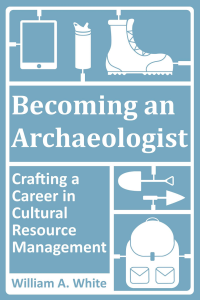 You’ve paid to attend a conference; traveled all the way to the venue. All is well, but you’re realizing several conflicts with the archaeology presentations you want to see. Some talks went long. Some are scheduled at the same as others. Basically, you aren’t going to see all the talks you wanted to see.
You’ve paid to attend a conference; traveled all the way to the venue. All is well, but you’re realizing several conflicts with the archaeology presentations you want to see. Some talks went long. Some are scheduled at the same as others. Basically, you aren’t going to see all the talks you wanted to see.
What can you do when this happens? Presently, there are few recourses. You’re just going to miss some talks. Many archaeo sages I know have long just accepted this as a fact of conferencing. But, it doesn’t have to be this way.
For far too long have we been simply acceding to the fact that we will not be able to see every conference presentation we’ve always wanted to see. But, what if someone recorded all the presentations so you could watch them on your phone, tablet, or laptop after the conference ended?
Recording Archaeology: The Solution
Doug Rocks-MacQueen (Doug’s Archaeology) is the mastermind behind Recording Archaeology. Over the last four years, he has recorded over 1,000 archaeology conference presentations and uploaded them to a YouTube channel. Recording Archaeology is a wealth of information and concepts that CRMers will find useful. From groundbreakingly simple concepts like harnessing Wikipedia for public archaeology purposes to discussing archaeology certifications to acknowledging the difficulty of building community archaeology projects to developing frameworks for UNESCO world heritage sites, Recording Archaeology is like a TED talk channel for archaeologists.
This is the archaeology channel real archaeologists have always wanted. It’s like having the chance to attend a conference all day, every day. For many of us that sounds like a nightmare but think about it: You’re only watching archaeology talks, not giving them. And, you can simply stop watching if the talk isn’t compelling without judgement or looking rude. While you won’t get the networking opportunities that come with conferencing, watching Recording Archaeology is a chance to give you the intellectual boost that comes with going to a conference.
Reasons to record
Having an archaeology channel is a game-changer. Never have archaeologists had access to so many conference presentations any time, any where we have internet/4G access. While the list of reasons why we should be recording our talks is endless, I’ve identified three main ones in the last few months since I’ve been watching Recording Archaeology:
1) Get information out to larger audiences: One of the things I recognized right away is the similarity in what is being presented. Archaeologists in Europe and the United States are presenting on similar, if not the same, concepts. This is happening because we all read the same materials and we do not have a rapid, reliable way of letting each other know what is happening on other sides of the Atlantic. Academic press paywalls and the lethargic peer-reviewed publishing system is one factor in this unawareness. The generally ineffective use of blogging, vlogging, and podcasting among archaeologists is another factor. I hope this blog post spreads the word about this resource.
Recording Archaeology is a near endless stream of presentations that remains largely untapped. Despite its robustness, most of the videos on Recording Archaeology have been viewed by fewer than 100 individuals (and, there is no way of knowing how many people actually watched the entire talk), which means few know about Recording Archaeology. I’ve started using some of these presentations in my classes at Berkeley but the dozens of talks I’ve watched is only a fraction of what has been uploaded to YouTube. Let’s start paying attention to what others archaeologists are doing.
2) Provide digital archive for talks: The weakness of all conference presentations is, once they’ve been given, they pass away into the ether of time. Any long-time archaeologist has seen a Society for American Archaeology or Society for Historical Archaeology talk cited as a reference, but we all know it is a data point to which only a small fraction of archaeologist will ever have access. Recording Archaeology creates an archive for conference presentations that will continually be migrated across programs for as long as YouTube exists, will remain available to the English-speaking world for free, and can be made accessible to visually or audio-impaired individuals through closed captioning and transcriptions.
Given the fact that The Digital Archaeology Repository (tDAR) does not accept audio or video files, YouTube can become a surrogate for these talks. Recent research has also shown that videos are the most popular content type on social media like Facebook than written posts, so adding talks to YouTube can create more exposure and reach for all your digital outreach platforms.
3) Access on multiple devices wherever: Artifacts can only be seen at museums and repositories. Most CRM reports can only be accessed in data centers or SHPO offices. Paywalls and high-priced books prevent peer-reviewed articles and books from reaching the people that need them the most (i.e. local communities where archaeology projects are happening). Likewise, conference presentations can only be seen in the present. The vast majority of archaeology can only be witnessed in three-dimensional form and/or in person, which means only a small population will ever have access to the wealth of archaeological materials and information that exist in the world.
Recording Archaeology makes archaeology much more portable and available to a much larger audience. All you need to watch the presentations on Recording Archaeology is a smartphone/tablet/computer, internet/3G or 4G access, and time. Except for time, these are things that most archaeologists have access to 24-hours a day. It also makes academic talks available to communities, which is the aim to which all public archaeology projects aspire.
All of this sounds great but there are two major hurdles to recording archaeology presentations:
Permissions to record
Getting permission to record talks is one of the biggest hurdles to recording all archaeology conference presentations. This requires ethical action on the part of the archaeologist but also an arrangement with the conference sponsoring organization.
Archaeologists should avoid recording sensitive talks when the content of the presentation is not amiable to recording (ex. When it’s a talk on digging burials or discusses traditional knowledge). For CRMers, some project proponents may not want the details of their projects made available to larger audiences. For example, a Forest Service manager may be okay with you giving a talk to a small audience of archaeologists but may not be okay with you broadcasting site locations on the internet for all to see.
Presentations that discuss sensitive or prohibited content should not be broadcast on YouTube. This is why a system of permissions has to be agreed upon in advance for all presenters. There also needs to be a mechanism for withdrawing a talk at the request of the presenter, project sponsors, administrative organization, for any reason. This runs against the tenets of most archival institutions that want materials preserved in perpetuity. But, the ability to add and withdraw content needs to exist to protect publics, presenters, and sponsoring entities.
Developing a flexible permissions system that is suitable to all archaeologists is easier said than done. Oftentimes, getting an appropriate permissions form takes more time than editing, uploading, and watching the content in question.
The fear that if you record it, no one will come
One of the major reasons why more conference presentations are not recorded and posted online is because conference organizing entities believe it will reduce conference attendance. (FYI: I believe recording archaeology presentations will actually do the opposite, especially if archaeologists start giving TEDtalks-style presentations rather than simply reading a paper they wrote). In the past, I’ve tried to get my presentations recorded so I could post them on the Succinct Research YouTube channel with little success. In fact, the only time I ever got my talk posted online is when Doug Rocks-MacQueen worked out an arrangement with the Society for Historical Archaeology to record an Equity Issues panel in Seattle. That was three years ago and it took a herculean effort.
Recording their conference talk is also not universally accepted by all archaeologists. Many do not want their talks recorded, which is perfectly okay. However, having a quality presentation made available to wider audiences via a platform like YouTube can be a career booster for assistant professors/adjuncts. It’s like having a 15-minute job talk available for every university to which you’re applying. If you’re networking properly and directing faculty to your information before you apply, they get a taste for your style and research before the job post goes live. Powerful talks on collaboration or novel solutions can also be an excellent commercial for CRM firms. Interesting information can give other companies ideas on how they can go about solving similar problems and your company’s talks get the word out about your capabilities.
Most importantly: Information is being shared. Recording talks does a much better job at this than making our presentations a “one-off” thing. I understand the apprehensions about decreased attendance, but the reality is, if students and other CRMers see the interesting things happening at your conference, the organization is more likely to increase attendance because the organization will be demonstrating its intellectual value. In truth, we go to conferences to network and intellectual stimulation comes a close second. But, cultural resource management and academic archaeologists are more likely to attend a conference they know something about. Recording talks and making them available is the best way to demonstrate your conference’s relevancy and value.
Recording Archaeology is the best kept secret for professional archaeologists and archaeology students. Log on and check it out today.
Write a comment below or send me an email.
 Having trouble finding work in cultural resource management archaeology? Still blindly mailing out resumes and waiting for a response? Has your archaeology career plateaued and you don’t know what to do about it? Download a copy of the new book “Becoming an Archaeologist: Crafting a Career in Cultural Resource Management” Click here to learn more.
Having trouble finding work in cultural resource management archaeology? Still blindly mailing out resumes and waiting for a response? Has your archaeology career plateaued and you don’t know what to do about it? Download a copy of the new book “Becoming an Archaeologist: Crafting a Career in Cultural Resource Management” Click here to learn more.
Check out Succinct Research’s contribution to Blogging Archaeology. Full of amazing information about how blogging is revolutionizing archaeology publishing. For a limited time you can GRAB A COPY FOR FREE!!!! Click Here
 “Resume-Writing for Archaeologists” is now available on Amazon.com. Click Here and get detailed instructions on how you can land a job in CRM archaeology today!
“Resume-Writing for Archaeologists” is now available on Amazon.com. Click Here and get detailed instructions on how you can land a job in CRM archaeology today!
 Small Archaeology Project Management is now on the Kindle Store. Over 300 copies were sold in the first month! Click Here and see what the buzz is all about.
Small Archaeology Project Management is now on the Kindle Store. Over 300 copies were sold in the first month! Click Here and see what the buzz is all about.
Join the Succinct Research email list and receive additional information on the CRM and heritage conservation field.
Get killer information about the CRM archaeology industry and historic preservation.




Hi! I guess DANS (dans.knaw.nl) and ADS can archive anything, have you tried there?
Thanks for commenting. I haven’t tried to archive video files. But, I will tell Doug Rocks-MacQueen–the vlogger behind Recording Archaeology. Perhaps they can help store this data.